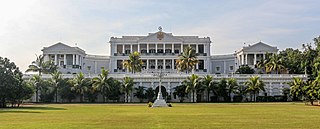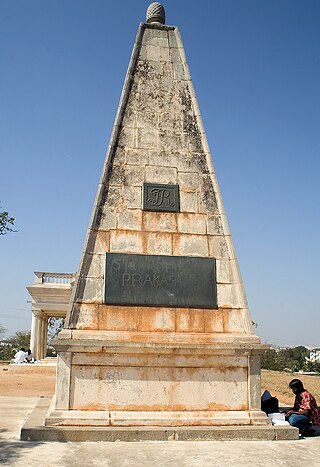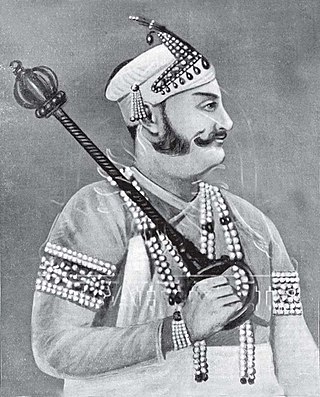
Paigah family was a noble family of Punjabi descent from the former Hyderabad State. The family maintained their own court, individual palaces, and a standing army of about fourteen thousand infantry and cavalry troops.

Chowmahalla Palace or Chowmahallat is the palace of the Nizams of Hyderabad State located in Hyderabad, Telangana, India. It was the seat of power of the Asaf Jahi dynasty (1720-1948) and was the official residence of the Nizams during their reign. Presently the palace is converted into a museum but the ownership still lies with the family.

Shamshabad is a census town in the Indian state of Telangana. It is located in Shamshabad mandal of Rajendranagar revenue division. Sri Vendikonda Siddalingeshwara Devastanam temple is situated in Siddulagutta Road in Shamshabad mandal. The international airport of Hyderabad is located here.

Falaknuma is a palace in Hyderabad, Telangana, India. It originally belonged to the Paigah family, and was later owned by the Nizam of Hyderabad. It is on a hillock and covers a 13-hectare (32-acre) area in Falaknuma, 5 kilometres (3.1 mi) from Charminar.

Basheer Bagh Palace or Bashir Bagh Palace was a palace located in Hyderabad, Telangana, India. It was constructed by Sir Asman Jah, member of Paigah noble family and Prime Minister of Hyderabad state (1887–1894). the palace no longer exists and was demolished in 1970s.
Malakpet is one of the neighbourhoods in the old city area of Hyderabad, Telangana, India. This is further divided into two parts, Old Malakpet and New Malakpet and is traditionally considered part of old city. This circle (6) comes under Charminar Zone of Greater Hyderabad Municipal Corporation. There are seven wards in this circle namely Saidabad (24), Moosrambagh (25), Old Malakpet (26), Akberbagh (27), Azampura (28), Chawani (29) and Dabeerpura (30).

Sir Viqar ul-Umara, Iqtidar ul-Mulk, Iqbal ud-Dowla, Secundar Jung, Nawab Muhammad Fazl-ud-din Khan Bahadur, was the Prime Minister of Hyderabad State from 1893 to 1901, and also served as the Amir-e-Paigah from 1881 to 1902.

His Excellency Amir e Paigah Basheerd-Ud-daula Azam-Ul-Umra Amir-e-Akbar Nawab Sir Muhammad Mazharuddin Khan Bahadur Rifa’at Jang, commonly known as Sir Asman Jah or Nawab Sir Asman Jah Bahadur, Asman Jah was one of those fortunate individuals to whom it has been given by fate to write their names large in the annals of their country, he was an Indian noble and member of the Great Paigah Family who served as Prime Minister of Hyderabad from 1887 to 1894. As the grandson of the premier noble Fakhr Uddin Khan Amir e Kabir Shams-ul-Umra I and of a princess of the blood, his social position was a great one; but the personal qualities he possessed, inherited largely from his grandfather, were unquestionably the means of bringing him to the front. Singularly gifted by nature as far as the outward man was concerned and excelling in all manly pursuits, he easily took the lead among his peers. But it was his mental and moral equipment which attracted the notice of his royal master while yet the young noble was in early manhood. Such was the promise he showed that His Highness the Afzal-ud-Daulah gave him his daughter in marriage and bestowed on him the highest distinction in his gift, the title of Jah.in 1869, Asman Jah entered on his public career as Minister of Justice. A little later on, while still retaining the portfolio of Justice, he acted as Prime Minister and co-regent. Later still he became a Member of the Council of Regency, and finally in 1887 he was appointed Prime Minister and continued to hold the office till 1893. In this connection it may be noted that throughout his long official career, Sir Asman Jah refused to take any salary while willing to take office he steadily persisted im refusing the emoluments of office. Elis regime as Premier was marked by several reforms, notably the advance made in education, the extension of medical aid by the State, especially aid to women, and the establishment of a permanent Board of Irrigation and city water supply, which has since been of excellent service to the State, Asman Jah was still in London when he got the news of his having been-appointed Prime Minister and one of the first to congratulate him on his appointment was his late Majesty King Edward VIL, then Prince of Wales, Asman Jah built several architectures throughout the city like Asman Garh Palace, Basheer Bagh Palace, saroonagar palace and Mahboob Chowk Clock Tower. Just before he was appointed to the premiership he was deputed by His Highness the late Nizam, Mahboob Ali Khan, to proceed in 1887 to London as his representative at the Golden Jubilee of Her late Majesty Queen Victoria. While in England he won golden opinions by the tact, savoir faire and high breeding he displayed His handsome presence, imposing address and polished manners impressed all classes of English Society and he became a great favourite in court circles. Indeed, the late Nizam could not have had a more dignified or worthier representative.

Paigah Palace is a palace in Hyderabad, India. It was built by Sir Vicar-ul-Umra, a Paigah nobleman. This was built after he gave the famous Falaknuma Palace to the sixth Nizam of Hyderabad state, Mahbub Ali Khan, Asaf Jah VI.

Paigah Tombs or Maqhbara Shams al-Umara, are the tombs belonging to the nobility of Paigah family, who were fierce loyalists of the Nizams, served as statespeople, philanthropists and generals under and alongside them. The Paigah tombs are among the major wonders of Hyderabad State which are known for their architectural excellence as shown in their laid mosaic tiles and craftsmanship work. Since it was Amir-e-Kabir H.E. Nawab Sir Khursheed Jah Bahadur who built the Paigah Tombs, he gave special preference in terms of construction to his immediate family. Of all the arches at Paigah Tombs, it is only the arch of his family's tomb that is bigger when compared with others. the entire necropolis was built earlier then the architecture would have been the same for all the tombs but instead in terms of architectural beauty, the tomb of Nawab Sir Khursheed Jah's family was given special preference. The largest arch and the double maqbara inside known as "Mahajar" cannot be seen inside any other tomb and also to mention the beautifully decorated stucco work in the tomb of Lateefunnisa Begum Saheba is not found in any other tomb. The tombstone of Lateefunnisa Begum Saheba, on which is already mentioned was built by Nawab Sir Khursheed Jah Bahadur. "Lateefunnisa Begum Saheba Jid'de Mohammed Mohiuddin Khan Khursheed Jah Tayyari ye Mohammed Mohiuddin Khan Khursheed Jah Bahadur." The word "Jid'de" over here would mean Grandmother of Sir Khursheed Jah Bahadur and "Tayyari'ye Mohammed Mohiuddin Khan Khursheed Jah Bahadur" would mean "Prepared by Khursheed Jah Bahadur." Inside this tomb are the graves of Nawab Sir Khursheed Jah Bahadur's immediate family members. Shahzadi Hussainunnisa Begum (Wife), Shahzadi Hashmatunnisa Begum (Mother), Amir-e-Kabir Nawab Mohammed Rasheeduddin Khan Bahadur (Father) and Hussaini Begum. The Paigah's necropolis is located in a quiet neighbourhood 4 km southeast of Charminar Hyderabad, at Phisal banda suburb, down a small lane across from Owaisi Hospital near Santosh Nagar. These tombs are made out of lime and mortar with beautiful inlaid marble carvings. These tombs are 200 years old and represent the final resting places of several generations of the Paigah Nobles.
Moosrambagh also Moosa Ram Bagh is an old suburb of Hyderabad, Telangana, India. It is named after the French military commander Monsieur Raymond who served the Nizams of the Hyderabad state during the 18th century. His tomb, Raymond's Tomb, is located near Asman Garh Palace. The locality of "Moosa-Ram-Bagh" is named after him. Wherein, Bagh refers to "a garden" as the area was once covered by extensive greenery.

The Old City of Hyderabad is a walled city of Hyderabad, Telangana, India, located on the banks of the Musi River built by Qutb Shahi sultan Muhammed Quli Qutb Shah in 1591 AD. There used to be a wall surrounding the Old City, most of which is destroyed. Mubariz Khan, the Mughal governor of Deccan Subah, had fortified the city in 1712 and was completed by Nizam of Hyderabad.

Raymond's tomb is the tomb of Michel Joachim Marie Raymond, a French general in the army of the 2nd Nizam of Hyderabad State, Nizam Ali Khan, Asaf Jah II. The tomb, located today in Hyderabad, India is a black granite tombstone, conical, about 7 metres high and it has the initials JR on it. The pavilion was built by the Nizam and collapsed in October 2001 in heavy rain.

The culture of Hyderabad, also known as Hyderabadi Tehzeeb or Dakhini Tehzeeb, is the traditional cultural lifestyle of the Hyderabadi Muslims, and characterizes distinct linguistic and cultural traditions of North and South India, which meet and mingle in the city and erstwhile kingdom. This blending was the result of the geographic location of the region and the variety of historical dynasties that ruled the city across different periods—its inception by the Qutub Shahi dynasty in 1591 AD, the occupation by the Mughal Empire and its decline, and the patronage under the Asaf Jahi dynasty.
The Telangana State Tourism Development Corporation is a state government agency which promotes tourism in Telangana, a state in the Southern region of India. The retired Director General of Police Pervaram Ramulu is the appointed First chairman of Telangana State Tourism. Tourist attractions in Telangana include historical places, monuments, forts, waterfalls, forests and temples.
The localities and neighborhoods of Hyderabad have unique oral histories, dating to the time of the Qutb Shahi dynasty, over 400 years ago, and are named after various people and things. Some are named after a major building or structure in the locality, others named for individuals. The names are mostly in Telugu and Urdu, the major languages of the city. This is a list of localities, neighborhoods and streets of Hyderabad and their etymology.

A distinct Indo-Islamic architecture style with local contribution is reflected in the historical buildings of Hyderabad, making it the first and "Best Heritage City of India" as of March 2012. The city houses many famous historical sites constructed during Qutb Shahi and Asaf Jahi period, including various mosques and palaces.

Amir-e-Paigah-e-Asman Jahi, Moin-ud-Daula Bahadur Innayath Jung, commonly known as Sir Nawab Muhammed Moin Uddin Khan born at Basheer Bagh Palace in 1891 was an Indian nobleman and member of the Paigah Nobility and the Amir of the Asman Jahi Paigah one of the 3 great Paigahs of Hyderabad State The Paigah Nobility was the second most powerful family in Deccan Hyderabad State maintaining their own court and army bound with Asaf Jahi dynasty by matrimonial relationship, Moin-ud-doula and his father Asman Jah was one of those fortunate individuals to whom it has been given by fate to write their names large in the annals of their country, Moin-ud-doula's father Asman Jah who served as co-regent and Prime Minister of Hyderabad created several marvelous architects throughout the city maintained his army court in his domain Shamshabad, was granted the title of Order of the Indian Empire,

Nawab Muhammad Abu'l Fateh Khan Bahadur, Taigh Jang Bahadur was an Indian nobleman and founder of the House of Paigah. He was also known as Abu'l Khair Khan II and conferred with the titles Shams ul-Umara, Shams ul-Mulk, Shams ud-Daula, and Imam Jung III.
















